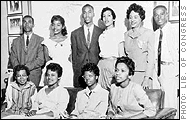Milestones in African American Education
Updated June 13, 2022 |
Infoplease Staff


Find information on Black history and the major milestones in African-American education, including the first institute established for Black students, the first Black law school in the United States, the end of segregation in public schools, and more.
 The Little Rock Nine
|
- 1837
- Institute for Colored Youth founded by Richard Humphreys; later became Cheyney University.
- 1854
- Ashmun Institute, the first school of higher learning for young Black men, founded by John Miller Dickey and his wife, Sarah Emlen Cresson; later (1866) renamed Lincoln University (Pa.) after President Abraham Lincoln.
- 1856
- Wilberforce University, the first Black school of higher learning owned and operated by African Americans, founded by the African Methodist Episcopal Church. Its president, Daniel A. Payne, became the first African American Uniiversity president in the country.
- 1869
- Howard University's law school becomes the country's first Black law school.
- 1876
- Meharry Medical College, the first Black medical school in the U.S., founded by the Freedman's Aid Society of the Methodist Episcopal Church.
- 1881
- Spelman College, the first college for Black women in the U.S., founded by Sophia B. Packard and Harriet E. Giles.
- 1881
- Booker T. Washington founds the Tuskegee Normal and Industrial Institute in Alabama. The school became one of the leading schools of higher learning for African Americans, and stressed the practical application of knowledge. In 1896, George Washington Carver began teaching there as director of the department of agricultural research, gaining an international reputation for his agricultural advances.
- 1922
- William Leo Hansberry teaches the first course in African civilization at an American university, at Howard University.
- 1944
- Frederick Douglass Patterson establishes the United Negro College Fund to help support Black colleges and Black students.
- 1954
- In the landmark case Brown v. Board of Education of Topeka, Kans., the Supreme Court rules unanimously that segregation in public schools in unconstitutional.
- 1957
- President Dwight D. Eisenhower sends federal troops to ensure integration of the all-white Central High School in Little Rock, Ark. The Little Rock Nine were the first Black students to attend the school.
- 1960
- Black and white students form the Student Nonviolent Coordinating Committee (SNCC), dedicated to working against segregation and discrimination.
- 1962
- James Meredith is the first Black student to enroll at the University of Mississippi; on the day he enters the university, he is escorted by U.S. marshals.
- 1963
- Despite Governor George Wallace physically blocking their way, Vivian Malone and James Hood register for classes at the University of Alabama.
- 1968
- San Francisco State University becomes the first four-year college to establish a Black studies department.
- 1969
- The Ford Foundation gives $1 million to Morgan State University, Howard University, and Yale University to help prepare faculty members to teach courses in African American studies.
- 2003
- In Grutter v. Bollinger, the Supreme Court (5-4) upholds the University of Michigan Law School's affirmative action policy, ruling that race can be one of many factors considered by colleges when selecting their students because it furthers “a compelling interest in obtaining the educational benefits that flow from a diverse student body.”
- 2007
- The Journal of Blacks in Higher Education surveyed the nation's highest-ranked research universities, the most selective liberal arts colleges, and the 50 flagship state universities to determine their levels of Black faculty. Mount Holyoke College had the highest percentage of Black faculty of any of the 100 colleges and universities surveyed, with 9.7%. According to the U.S. Dept. of Education, the 2007 national average was 5.4%.
- 2008
- The percentage of all 18- to 24-year-old African Americans enrolled in higher education increases to 32.6% from 21.2% in 1988.
- 2010
- President Barack Obama issues an executive order creating the White House Initiative on Historically Black Colleges and Universities (HBCUs). The order says that the government, the private sector, non-profits, and other groups will work with these institutions to provide a high-quality education to a greater number of Black students.
- 2012
- President Obama signs an executive order creating the White House Initiative on Educational Excellence for African Americans. The initiative is intended to improve the educational achievement of African Americans and make sure they are given the opportunity to complete high school, college, and embark on a productive career. "Significantly improving the educational outcomes of African Americans will provide substantial benefits for our country by, among other things, increasing college completion rates, productivity, employment rates, and the number of African American teachers," the executive order declared.
| Historically Black Colleges and Universities (HBCUs) | Higher Education | Selected Degree Abbreviations |
.com/ipa/0/8/7/2/8/4/A0872844.html
About the author







